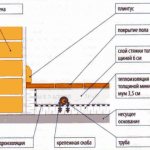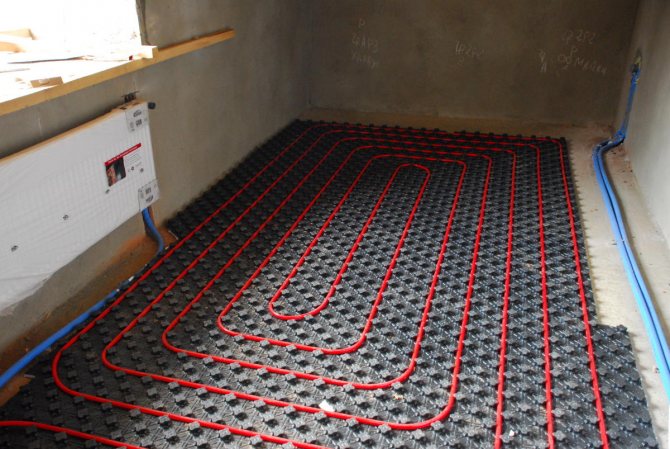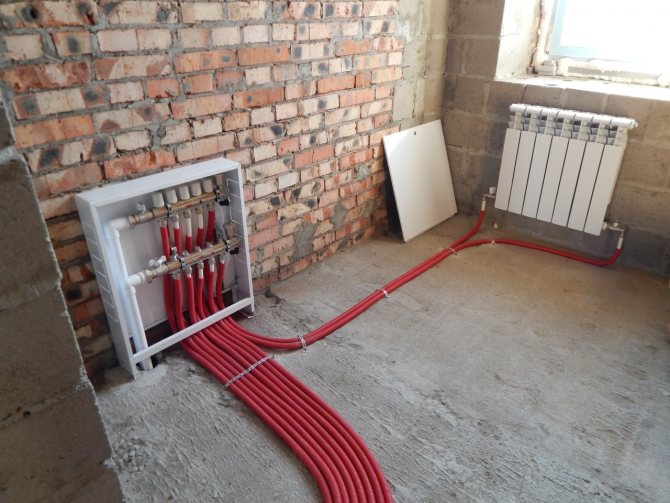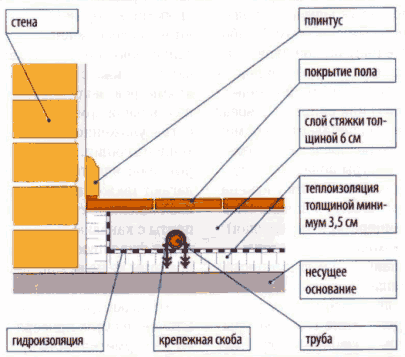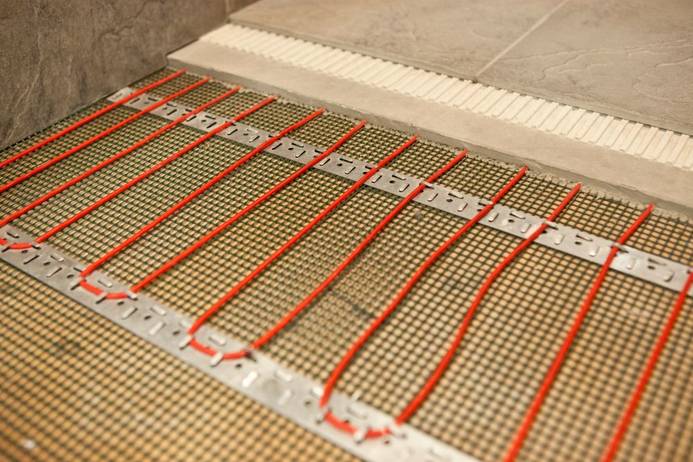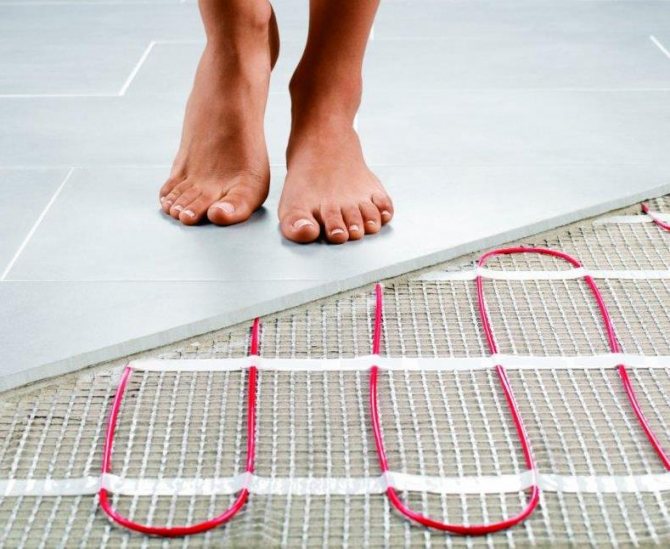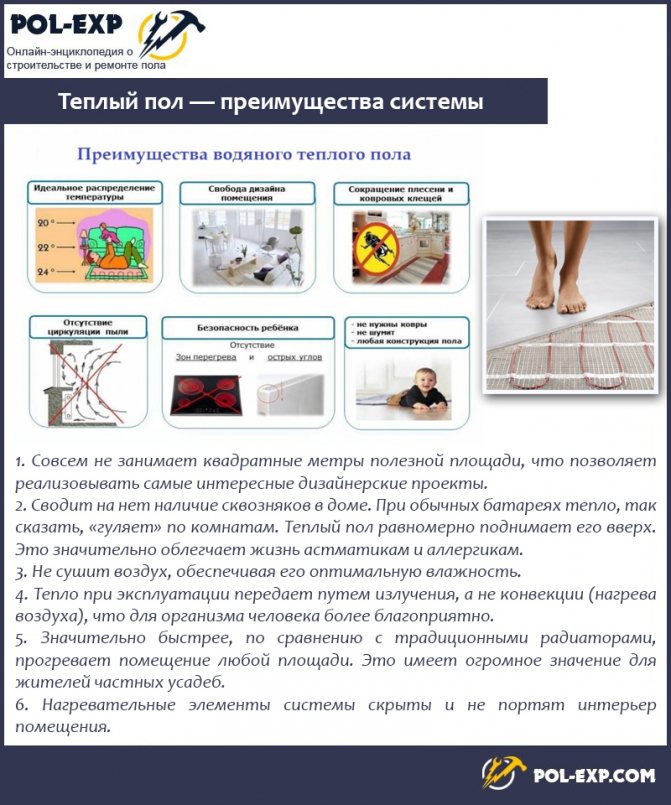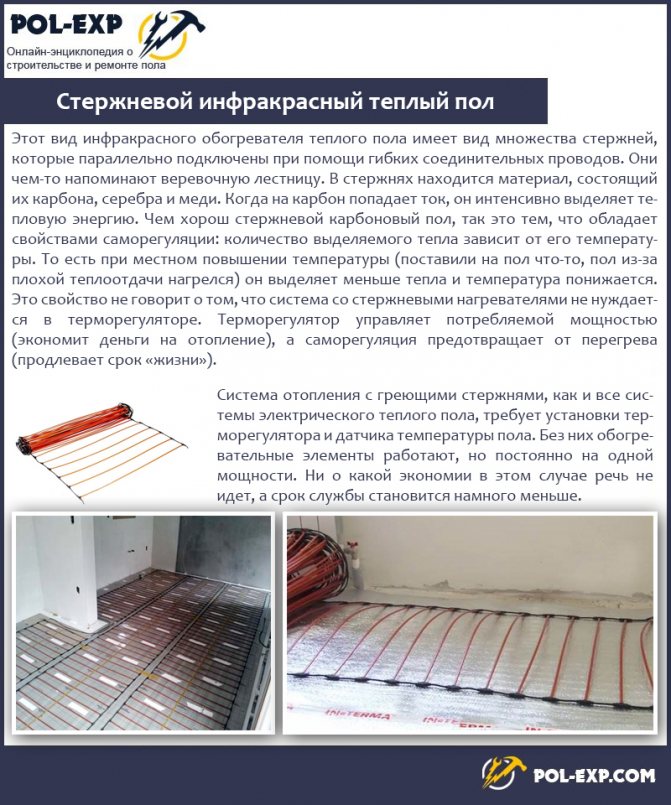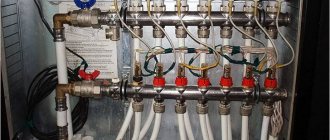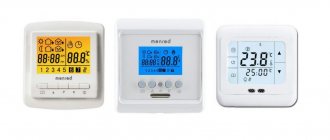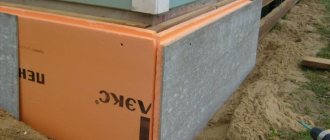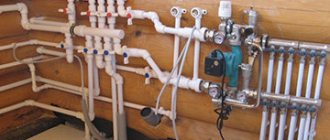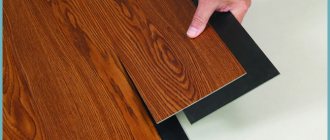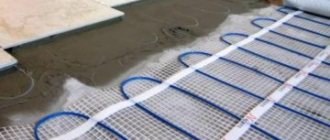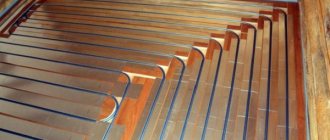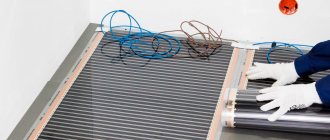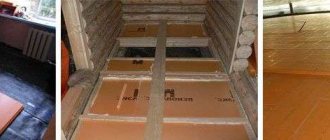Warm floor in a private house
Maximum underfloor heating temperature
|
| Warm water floor in a private house. The thickness of the vertical insulation between the wall and the screed must be the same as the horizontal one. |
The maximum floor surface temperature is limited to 29 ° C. Higher temperatures are unhealthy. It is recommended that in the area of permanent residence of people the floor temperature does not exceed 26 ° C. Along the outer walls and next to the windows, the floor can be heated up to 33 ° C to compensate for the increased heat loss in these areas.
The same floor temperature can be maintained in a bathroom, where people stay for a short time, and often without shoes. Due to the limitation of the floor surface temperature, the maximum power density of the underfloor heating system is 80 W / m2.
Maximum power of underfloor heating in a private house
A power of 80 W / m2 may not be enough for rooms with high heat losses, for example, with very large windows.
Problems can also arise in a small room, for example, in a cramped bathroom, in which, after installing a bath or shower, and other sanitary appliances, only a small area of the floor remains where you can lay the underfloor heating system.
The same can be true in small bedrooms, where a large bed and wardrobes cover a significant part of the floor, thereby reducing the efficiency of the underfloor heating system.
For example, a warm floor with an area of 10 m2 can deliver a power of 800 watts. The same power is provided by a panel radiator measuring only 50 x 50 x 15 cm due to the fact that its temperature is significantly higher than the temperature of the floor (in practice, 70-80 ° C).
For each room of a private house, you can choose a radiator of the required power, but it is not always possible to heat any room in the house with a warm floor.
The strength of the floors of a private house
The use of underfloor heating systems can be limited due to the additional load on the floor, since the pipes of the system must be laid in a fairly thick layer of heavy concrete screed.
When deciding on the installation of a warm floor in a private house, you need to make sure that the load on the floor from the weight of the screed will not be excessive.
Please note that the thickness of the warm floor can significantly reduce the height of the room.
Warm floor will provide comfort and health.
The temperature distribution along the height, which is closest to ideal, is provided by the underfloor heating system, Fig. 1.
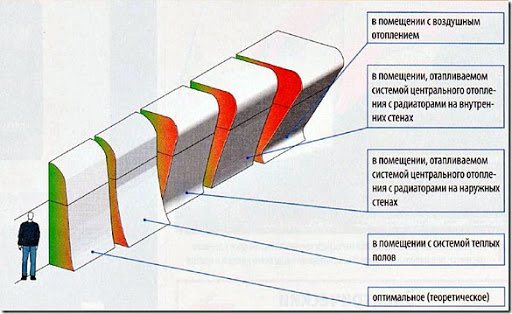

Thermal comfort conditions
- that is, such a state in which we are neither cold nor hot - are observed if the temperature of the heating surface does not exceed the temperature of our skin too much, and the air temperature does not differ very much from the average temperature of the surfaces around us - walls, floor and ceiling.
This is only possible when using low-temperature underfloor heating, in this case underfloor heating. Moreover, the floor has a very large effect on the feeling of thermal comfort,
because this is the only enclosing surface with which we directly contact - through the feet of the feet, which are very sensitive to temperature.
It is especially desirable to use an underfloor heating system if a material with a high coefficient of thermal conductivity will be used as a floor covering, for example, stone or tiles, which seem cold to the touch.
Hyp allergenic floor heating
An important advantage of the underfloor heating system is no dust burning phenomenon,
due to the lower temperature of the heating surface. At temperatures above 55 ° C (the surface of the radiator usually has a higher temperature), the process of dry distillation of organic dust particles begins, which, rising up together with warm air, irritate the mucous membranes of the respiratory tract, causing a sensation of dryness in the throat.
Allergic reactions to dust depend not so much on the number of inhaled particles, but on their type - when heated to a temperature of more than 55 ° C, they increase in volume and irritate the mucous membranes even more. Therefore, low-temperature heating, which is a warm floor, in contrast to traditional radiator heating practically does not cause allergic reactions.
Do you need a warm floor in a private house - a source of comfort and health? The answer, I think, is obvious.
Electric floor
For residents of high-rise buildings, this is the only way to legally lay underfloor heating. It is usually made in unheated areas where it acts as the only source of heat. For example, on a loggia, balcony or veranda. Sometimes a warm floor saves feet from cold tiles in the bathroom. It is possible to lay underfloor heating both in an old socket and in a new building.
But do not forget about the wiring in the house and the power consumption. If your wiring is flimsy, it simply won't pull the heater.
There are several types of electric flooring.
Cable underfloor heating
The cable system, made of high thermal conductivity alloys, is laid under the floor. Correct the temperature using a regulator that is part of the underfloor heating.
Benefits:
- Durability of work.
- Serves as an additional (or main) heat source.
- Can add a few degrees in cold rooms.
Minuses:
- It is advisable to pay attention to certificates that guarantee the environmental friendliness of materials.
- The cost of installing the system (like the equipment itself) is high.
- Electricity costs can be high, depending on the tariffs in your area.
Useful for you: heating cable "GREEN BOX". Length - 17.5 m, heating area 1.65 sq. M. Power - 127 W / sq.m.Price - from 2370 rubles.
Roll Tilit Super TP with an area of 18 sq.m. Made of foamed polyethylene with markings and foil cover. It will help to reduce installation time and evenly distribute the elements. The foil protects against the aggressive effects of the screed.
Price - from 120 rubles per 1 sq.m.
Infrared floor
Instead of a system of cables that are mounted in a tie, a thin film is laid. This is an infrared underfloor heating that is energy efficient. Consumes no more than 150 W per 1 sq. M. That is, 1.5 kW per 10 sq. M. This is a universal solution that fits perfectly under any coating except parquet floor: the film will quickly "dry out" it. When the equipment is turned on, it emits infrared rays. The maximum heating temperature is +55 degrees. It is not dangerous and will not cause a fire. Moreover, the thickness of such a floor is negligible: only 0.5 mm!
Benefits:
- Easy to install. Don't feel like messing around with a concrete screed? Then the film floor is your option. You can easily lay the sheeting even under the carpet.
- Film heat-insulated floor can be laid on any surface except wood.
Disadvantages:
- There are many hidden contacts that can be damaged if you carelessly use a film warm floor.
- You will have to purchase connectors to hold the wires and film together. This is the only way to ensure tight contact.
- For ceramic tiles, you need to make a screed, which will increase your investment.
Comes in handy: Eastec infrared floor heating. Consumes 220 W per 1 sq. M. in operation and 40-60 sq.m. In standby. Width - half a meter. Price - from 640 rubles. for 1 sq.m.
Electric mats
Scrolling through the pages of online stores, you will definitely see an image of electric mats. They look like a kind of mesh to which the heating elements are attached. This is an almost finished warm floor that can be quickly installed at home.
Benefits:
- The equipment is easy to install: you do not have to fiddle with the installation of electrical cables.
- The system has a thermostat and can be easily adjusted.
- Suitable for rooms with high humidity, such as bathrooms.
- He is not capricious: you can use a different adhesive base for the screed, without fear that it will damage the mat and its elements.
Disadvantages:
- High cost.
- It is easy to run into a fake, which will quickly fail.
It will be useful for you: underfloor heating on the EASTEC ECM grid with a heating area of 0.5 sq.m. Power - 160 W / sq.m. Price - from 1673 rubles.
Electrolux EMSM 2-150-1 heats from 1 to 1.35 sq.m. With triple insulated conductors, power density 150 W / m2. Price - from 4790 rubles.
Underfloor heating in a private house saves heat energy
The comfortable temperature in a room with underfloor heating is 2 ° C lower than with radiator heating.
This reduction in temperature can save up to 5% of heat energy for heating. This is due to the phenomenon of heat radiation by our body in the direction of cold surfaces - in this case, the floor.
If the floor is warmer, in its direction less heat is radiated from our body,
therefore, the required comfortable thermal balance is achieved at a lower room temperature. This is the most important advantage of radiant heating.
The possibility of a slight decrease in the room temperature without loss of comfort is also influenced by temperature distribution over height.
If your feet are warm, the room temperature may be slightly lower without discomfort.
Heating the house with underfloor heating.
Directly answering the question posed - it is impossible. It is impossible because the "warm floor" as an independent structure does not produce heat. In order for the warm floor of any system to heat, a certain amount of energy must be supplied to it. In addition, a warm floor as a heating device has a number of significant design flaws:
- it is placed on the floor structure, which automatically reduces the heat-emitting surface in half.
- since it has direct thermal contact with the floor structures, the supplied heat is spent on heating the structures.
- decorative finishes, carpets, furniture, household appliances will certainly be placed on the floor surface, which inevitably reduces the efficiency of the warm floor in comparison with all other heating devices.
If you are no longer satisfied with the "old stove", the existing heat generator in the house, then it just needs to be replaced with a modern one. Which heat generator to choose, and one for which the cost of the produced 1 kW of thermal energy will be minimal. If in your area there is cheap electricity and significant electrical power is supplied to the house, then you can do only by installing electric convectors of the required power in the serviced premises. However, you can hardly find cheap electricity in the required quantities in the Russian Federation. Therefore, it remains to use a heating boiler as a heat generator. Heating household boilers are currently a fairly large selection. Depending on the cost of fuel in your area, you need to choose the boiler with the lowest cost of 1 kW of heat energy produced. You can see how to do this here. In the internet, you can easily find the calorific value of any fuel. My recommendation, since your house is not gasified and you have to import fuel for the boiler, consider the use of diesel fuel (diesel fuel), propane-butane (liquefied petroleum gas), and fuel pellets (pellets). Each of these fuels has its own advantages and disadvantages.By connecting a heating boiler to a liquid heating system, you are guaranteed to forget about "ash and chips". However, I must warn you that your heating system will only work effectively if it is assembled in accordance with a project designed specifically for your home.
Warm floor is a heat accumulator.
The warm floor heats up several times longer than the radiators - before the heat begins to be transferred to the room, the concrete slab must be heated, in which the pipes with the coolant are placed. The heated concrete slab will give off heat after a long time
after shutting off the flow of coolant into the system.
The ability of a warm floor to be a heat accumulator, to slow down the processes of temperature changes in the room, optimizes and stabilizes the operating mode of a heating boiler, especially a solid fuel one. More about this read here.
At the same time, underfloor heating is more difficult to adapt to rapidly changing heat demand with a sharp change in outdoor temperature. This can lead to overheating of the premises, that is, to unnecessary heat loss. Or vice versa, to underheating and reduced thermal comfort. High thermal inertia
also makes it difficult to periodically drop the temperature during the absence of residents.
Surface temperature and inertia of underfloor heating
Many designers include not very negative temperatures in the winter in the project. Those. at -5 ° C, the system copes, but in our latitudes the values can fall to -25-30 ° C and stay at this level for a week, then problems begin.
Another negative point is the inertia of the warm floor. It takes about 60-65 hours to fully warm up the room to 20 ° C when the system is started. It turns out that if you left for a long time and turned off the heating, then upon arrival you will not be able to quickly warm up the house.
This happens due to a significant layer of concrete screed, which heats up first, then the flooring begins to warm up and at the last moment the heat is released into the air. The same applies to airing the room, just opening the window in the bedroom will be problematic, it will take up to 2 hours to reheat. We'll have to use the same recuperators, but these are additional costs, we wrote a separate article about them.
Automatic control of underfloor heating in a private house
Automatic control of the heating system is necessary to maintain a comfortable temperature in the premises, as well as to optimize energy consumption.
The lack of regulation can lead to overheating of the premises and increased heat consumption.
The figure below shows control circuit diagram
a mixed heating system of a private house - using underfloor heating and radiators.
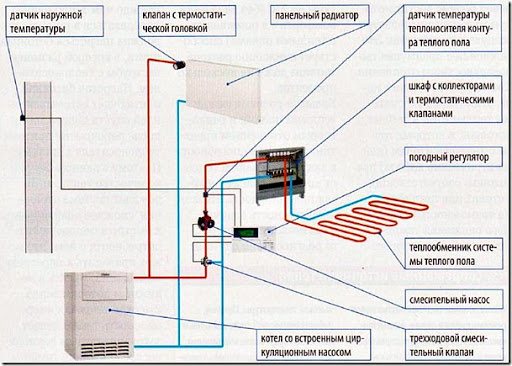

To control the radiator system, the automation is sufficient, which is equipped with the boiler, supplemented by thermostatic valves installed on the radiators. Connecting the underfloor heating circuit to the heating system requires the use of additional devices that reduce the temperature of the coolant entering the system - mixing pump and three-way mixing valve.
Warm floors with a weather regulator
Considering that the underfloor heating system has a high inertia (heats up slowly and cools slowly) to control its operation, it is recommended to use weather automation.
Then the temperature of the heating medium supplied to the system will be adapted to the outside temperature. Due to this, together with a change in the outside temperature, the temperature of the heating medium circulating in the floor changes.
When regulating with a room thermostat, the temperature of the coolant in the system will not change until it starts to rise in the room (due to warming outside).Only after this, the temperature of the coolant will begin to decrease, but due to the inertia of the system, it will already become hot in the room (that is, irrational consumption of energy).
Therefore, to make the heating of the house economical, a weather regulator must be used to control it in the underfloor heating system.
When heating with radiators, satisfactory results can be achieved by using cheaper thermostats.
Installation work
Before you decide to innovate and equip a warm floor at home, you need to think through the following details:
- What is the heating area.
- Where are the walls (external and internal floors)
- What type of house: private or high-rise building.
- You are going to use the equipment as main or additional heating.
Water floor: stages of work
Laying the floor is a delicate matter. Heating efficiency depends on the even distribution of pipes. The coolant (water) gradually cools down passing through the pipes. They should be mounted from the center to the walls. This will ensure a more even distribution of heat into the room. There are several ways to install a water floor. It can be arranged according to the "snail" principle, when pipes are laid in a spiral starting from the middle of the room. It is best to choose this option if you are installing a warm floor in an inner room, the walls of which do not face the street. For example, in the bathroom. Or a room with a balcony. But almost all rooms have windows, which means that the walls go out. In this case, it is better to do the styling "snake" or combine the two methods.
How to do the styling?
You need to dismantle the old screed and create the perfect floors: clean, level the top layer. After that, a waterproofing layer is laid. Then there is a damper tape, which helps to evenly distribute the heating over the floor surface. Following it, insulation is sent to the warm floor layer. It can be foamed polyethylene foil on one or both sides. You will need it if you are making a warm floor as an additional source of heat. You can choose extruded polystyrene foam. It will serve if you make a warm floor higher than the second floor. For an unpaved floor, choose polystyrene that complements expanded clay. The thickness of the expanded polystyrene is 10 cm.
Pipes are laid on top of the insulation through which the coolant will circulate. They have special requirements. They must withstand a pressure of at least 10 bar, a temperature of +5 degrees, and their size is up to 2 cm in diameter. Lay the pipes carefully, avoid stretching them at bends. Fasten the ends of the pipes to the manifold, then use polyethylene foam for fastening. And lay laminate or linoleum on top of the structure as a decorative floor covering.
Important. When laying a warm floor, a vapor barrier is required, on top of which a heater is placed. You can use reflective insulation instead of vapor barrier.
Electric underfloor heating: stages of work
It is expensive to fully heat a house with this method. But you can lay an electric floor as an additional source of heat. For example, in the nursery. Or make it a source of heating on the balcony, veranda, bathroom.
The complexity of the installation work depends on the type of electric floor. The hardest part will have to do with the electrical cable system. They are mounted in a screed, placing the floor covering on top. Or on top of the screed, under the laminate. The approximate "front of work" looks like this.
You need to prepare the surface, remove the old screed. Lay a layer of waterproofing and fix a damper tape around the perimeter of the room. Next, the insulation is laid. If you work in an unheated room, you will need a 10 cm layer of insulation (mineral wool, polystyrene). Lay reinforcing mesh on top and lay out electrical wiring. For uniform application, you can lay special markings under the warm floor. This will lay out the heating elements at a specific pitch.
Film floor: stages of work
The easiest and fastest way to make a warm floor at home. If you have no desire to engage in dismantling the previous screed and create a new one, infrared floors are suitable for you. Just lay the foamed polyethylene foam on the floor. Next is the film floor, and waterproofing can be used. Basically, that's it. Laminate or linoleum can be mounted on top. Just pay attention to the tightness of the contacts. And do not place bulky furniture on the film floor: the system may fail.
Aesthetics of underfloor heating in a private house
The heating system, first of all, must provide thermal comfort, as well as function smoothly, and at the same time it is very desirable that it does not interfere with the tenants.
One of the advantages of the underfloor heating system is that it is not visible.
In the underfloor heating system, heating elements are pipes that are laid in the floor and do not interfere with the decoration of the premises.
Certain restrictions apply only to the choice of flooring,
since not all of them are suitable for use with underfloor heating systems. Some are not intended for operation at elevated temperatures - they emit harmful substances, deform, crack, lose their appearance, others are good thermal insulation, which makes it difficult to heat rooms.
It is best to use materials with a high coefficient of thermal conductivity - stone or ceramics - for flooring.
These are the most suitable materials for underfloor heating, the rest make it more difficult to transfer heat to rooms.
But this does not mean that carpet, laminate or wood panels cannot be used as flooring. You should only adhere to the recommendations regarding their installation on a floor with a heated floor system.
For example, laminate and linoleum must be specially marked to indicate that they can be installed on a heated floor. It is recommended to use wood coverings with a thickness of no more than 2 cm.
The only remaining visible element of the underfloor heating system is the control cabinet, which contains the control valves of the individual heating loops. Usually, one wardrobe is installed on the floor of the house, which is located in an inconspicuous place - in the hallway, wardrobe or utility room.
Rules for preparing a country house
Regardless of the presence or absence of heating, it is desirable to insulate the country house in any case. Moreover, you need to insulate not only the floor, walls, but also the roof. This will keep the house warm in winter and cool in summer.
- The rough base must be prepared for the installation of a warm floor. In the case of an uninsulated floor, it must be opened, covered with rubble and expanded clay with a layer of about 30 cm.
- Next, the membrane waterproofing is laid and the insulation is laid (thickness - 20 cm).
- A 5 cm cement screed is poured.
- A special moisture-repellent impregnation is applied over the screed.
- It is also important to glue a damper tape around the perimeter of the floor to the walls.
- The underfloor heating cable must be laid on a reflective screen, previously laid.
- Next, the heated floor is mounted directly.
- At the end is executed screed... If the underfloor heating is liquid, then 80 mm thick, and if it is mats or cable, then 50 mm. As for the IR film, a screed is not required for it.
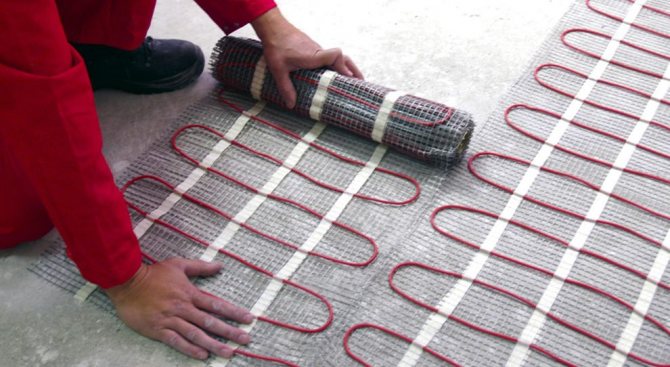

Underfloor heating on a concrete base
Note! Wooden floors are covered with lathing between the logs. Preparation is carried out in the same way as described above, but instead of a screed, the heating elements are covered with fiber-cement boards or drywall.
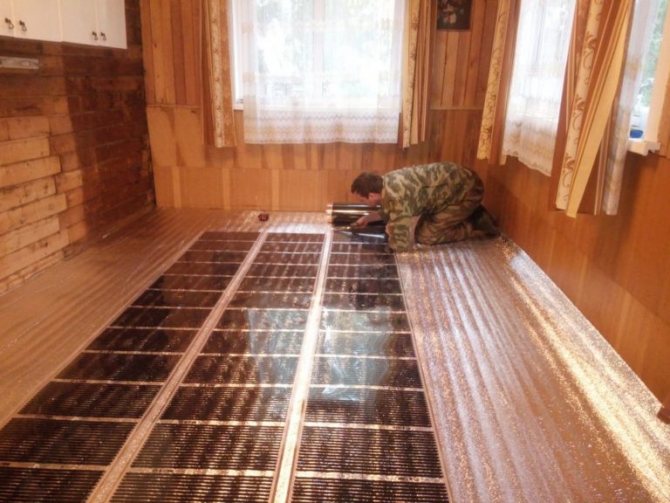

Heating on a wooden floor
The system is mounted on a foil substrate, and a wooden crate is made on top. The infrared foil can be laid directly on the wood floor.
Prices for underfloor heating REHAU
Warm floors REHAU
Do you need underfloor heating in a private house?
Underfloor heating is a rather expensive system and you can do without it, but the created comfort is worth spending money on installing it.
What to choose? Is it worth paying more to get something better? It depends on how strong this desire is and how much you need to pay.
The cost is determined by the need to install a thicker layer of thermal insulation, a thicker layer of screed, and the use of a more complex control system. During its execution, there is a greater likelihood of making mistakes, and their correction and elimination of the consequences of a possible accident is usually a more expensive process.
When installing floors in the house on the ground, a warm floor in a private house is the best solution - the additional costs will be relatively small and justified by the increased thermal comfort.
In the case of heating a house with a solid fuel boiler, it is advisable to use a warm floor and as a heat accumulator.
The experience of operating underfloor heating shows that the system is very reliable and there are rarely problems with it. It is sufficiently mastered, and its installation should not cause difficulties for specialists. The higher cost and the higher risk of “something going wrong” is the price to pay to enjoy the comfort of underfloor heating.
The most versatile is frequently used mixed system solution,
in which part of the premises (for example, bedrooms) is heated by radiators, and the rest - where the flooring is ceramic or stone tiles (living room, kitchen, bathrooms, toilets) - with underfloor heating system.
Do you need underfloor heating in a private house? - I hope this article will help you make the right decision.
Do you need underfloor heating in a private house? Vote!
Find out what others have chosen.
Look!
- all polls
More articles on this topic:
⇒ Dry heat-insulated floor in a wooden house
⇆
More articles on this topic
- Do-it-yourself floor with a dry prefabricated screed made of gypsum fiber board or particle board
- Concrete floor on the ground in a stone private house
- Floating floor - soundproofing of floors in the house
- Wooden floor on logs on the first floor of a private house
- Ground floors on the first floor of a private house without a basement
- Prefabricated dry floor screed made of sheets of gypsum fiber board, chipboard, OSB, plywood
- How to make the right concrete floor in a timber or frame house
- How to make a floor screed in a private house
Calculating savings
Electric floor
... On average, the price of one square meter of underfloor heating (electric mat) costs from $ 50. Of course, before making such investments, you need to calculate the economic feasibility. Will it be beneficial during the heating season? Will heating bills go down?
Let's consider the example of a three-room apartment (60 sq.m.). In general, the electric floor will pull 6 kW. But it does not operate at full capacity around the clock, so it is worth applying a factor of 0.5. At the end of the month, electricity consumption will be more than 2000 kW. How economical it is, look at your region. After all, the cost of 1 kW can vary 3-4 times.
For example, residents of the Irkutsk region pay 1.01 rubles. per kWh, Muscovites - 5.38, and in the Chukotka Autonomous Okrug - 8.2 rubles. per kWh. Therefore, in Moscow, heating a three-room apartment with an electric floor will cost about 11 thousand rubles.
However, the figure you get will not be final. If you install a two-rate meter, thanks to which night heat is much cheaper, you can save a lot.
But heating the whole house with an electric warm house is really expensive. It is easier to use it as a source of comfort in the bathroom or toilet, so that the tiles do not cool the delicate legs. Then you wind up a little more than 1 kW on the heating. And additionally pay about 1.5 thousand rubles for comfort.
Water floor.
Combine a water-powered floor heating with a geothermal pump. This will give you the most savings.Why geothermal? It draws its energy from the ground and can provide enough heat to heat the house even in winter. You put the hot water that it heats up not into the usual batteries, but into the warm floors.
But such a system must be designed immediately. You will not be able to quickly rebuild everything anew before the heating season. Other options for a water floor are possible: joint work with a gas boiler. The boiler will additionally consume about 1 kW of electricity. If it is a supplement to the battery system, then the cost of gas heating can increase by 30%. If desired, you can refuse radiators, leaving only a warm floor.
It is important not to miss the coating. For example, when choosing linoleum or laminate for underfloor heating, pay attention to the operating temperature. It should be at least + 40-45 degrees.
Floor preparation
Before laying the insulation system on the floor, it is necessary to prepare it. Floor differences should not exceed 3 mm per 1 meter.
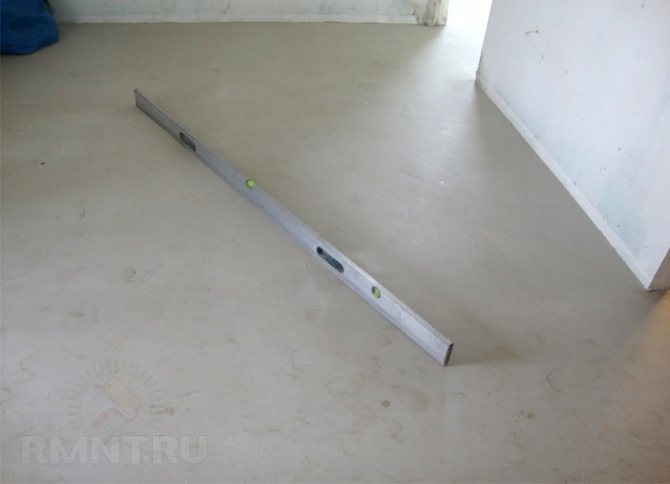

Checking the quality of the subfloor
If there are old floors in the room (wood, laminate, linoleum), then they need to be dismantled. Weak and peeling areas must be removed. Then prime the entire floor with a deep-penetrating primer according to the manufacturer's instructions. Further, after the primer has dried, it is necessary to fill in a preparatory bulk cement mixture, which has a high leveling ability. If the differences in the floor exceed 5 mm, then it is necessary to fill in with a starting self-leveling leveling mixture, with differences of less than 5 mm, finish self-leveling self-leveling floors are poured. Such a surface is environmentally friendly, and in the future will have high wear and water resistance.
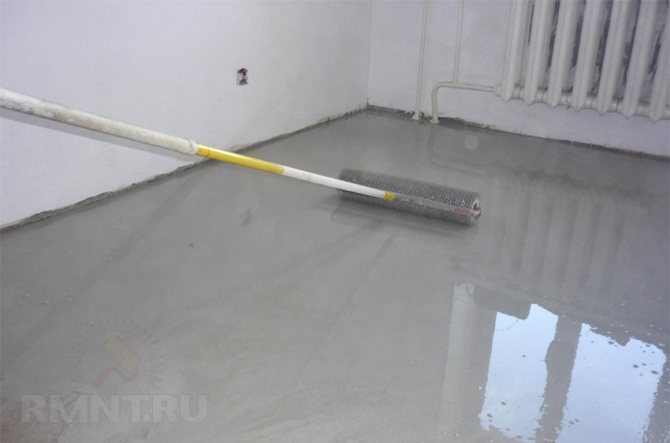

Pouring the self-leveling floor
To do this, you need to take a bucket with a volume of 20-25 liters, pour 10 liters of water into it. Gradually pour the dry mixture into the water, stirring with a mixer with a whisk until the mixture is homogeneous and without lumps, and the density has the consistency of liquid honey (the mixture should be poured out, but not spread like water). The finished mixture must be poured onto the prepared floor immediately after preparation, since it quickly settles in the bucket and you need to mix it again. After the solution is poured onto the floor, it is leveled over the floor surface as a rule, and then evenly rolled out with a spiked roller. Such a surface, as a rule, hardens after 6-10 hours, and after a day you can confidently walk on it. After 2 days, further work can be carried out.

